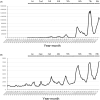Effects of an increase in emergency cases with difficulties in transport to hospital during the COVID-19 pandemic on postoperative short-term outcomes of colorectal perforation: A study based on the National Clinical Database
- PMID: 40385336
- PMCID: PMC12080204
- DOI: 10.1002/ags3.12887
Effects of an increase in emergency cases with difficulties in transport to hospital during the COVID-19 pandemic on postoperative short-term outcomes of colorectal perforation: A study based on the National Clinical Database
Abstract
Aim: During the COVID-19 pandemic, there were delays in transport of emergency cases to hospital by ambulance due to increased difficulties in obtaining hospital acceptance. The aim of this study was to examine if this had a negative effect on postoperative short-term outcomes in patients with colorectal perforation.
Methods: The National Clinical Database (NCD) includes >95% of surgical cases in Japan. Postoperative 30-day mortality, surgical mortality, and postoperative complications (Clavien-Dindo grade ≥3) were examined in 17 770 cases of colorectal perforation registered from 2019 to 2022 in the NCD. These outcomes were compared for cases with new COVID-19 infection and emergency cases with difficulties in transport to hospital. Months were considered to have significantly high or low mortality or complication rates, if the 95% confidence interval (CI) of the standardized mortality (morbidity) ratio (SMR) did not contain 1.
Results: Postoperative 30-day mortality occurred in 1826 cases (10.3%), surgical mortality in 2382 cases (13.4%), and postoperative complications in 5276 cases (29.7%). Significantly higher SMRs were found for 30-day mortality in November 2020 (1.44 [95% CI: 1.07-1.89]) and February 2021 (1.54 [95% CI: 1.14-2.03]), and for postoperative complications in June 2020 (1.27 [95% CI: 1.07-1.50]). In 2022, there were marked increases in new COVID-19 cases and in emergency cases with difficulties in transport to hospital, but no month had a significantly high SMR.
Conclusions: Emergency cases with difficulties in transport markedly increased during the COVID-19 pandemic but had little effect on short-term outcomes of colorectal perforation.
Keywords: COVID‐19; National Clinical Database; colorectal perforation; emergency cases with difficulties in transport to hospital; postoperative short‐term outcomes.
© 2024 The Author(s). Annals of Gastroenterological Surgery published by John Wiley & Sons Australia, Ltd on behalf of The Japanese Society of Gastroenterological Surgery.
Conflict of interest statement
Hideki Endo and Hiroyuki Yamamoto are affiliated with the Department of Healthcare Quality Assessment at the University of Tokyo. The department is a social collaboration department supported by grants from the National Clinical Database, Intuitive Surgical Sarl, Johnson & Johnson K.K., and Nipro Co. Masaki Mori is Emeritus Editor‐in‐Chief of Annals of Gastroenterological Surgery. Hideki Ueno is Associate Editor of Annals of Gastroenterological Surgery dealing with the lower digestive tract. Yoshihiro Kakeji and Ken Shirabe are editorial members of Annals of Gastroenterological Surgery. The other authors declare no conflict of interest for this article.
Figures



Similar articles
-
Effects of the COVID-19 pandemic on short-term postoperative outcomes for colorectal perforation: A nationwide study in Japan based on the National Clinical Database.Ann Gastroenterol Surg. 2023 Nov 23;8(3):450-463. doi: 10.1002/ags3.12758. eCollection 2024 May. Ann Gastroenterol Surg. 2023. PMID: 38707225 Free PMC article.
-
Effects of the COVID-19 pandemic on short-term postoperative outcomes of emergency surgery for gastroduodenal perforation: A nationwide study in Japan based on the National Clinical Database.Ann Gastroenterol Surg. 2024 Apr 15;8(5):795-806. doi: 10.1002/ags3.12806. eCollection 2024 Sep. Ann Gastroenterol Surg. 2024. PMID: 39229559 Free PMC article.
-
Aspects of survival from colorectal cancer in Denmark.Dan Med J. 2012 Apr;59(4):B4428. Dan Med J. 2012. PMID: 22459726
-
IMPACT OF THE COVID-19 PANDEMIC ON THE EMERGENCY SURGICAL TREATMENT OF COLORECTAL CANCER.Arq Bras Cir Dig. 2024 Feb 5;36:e1793. doi: 10.1590/0102-672020230075e1793. eCollection 2024. Arq Bras Cir Dig. 2024. PMID: 38324854 Free PMC article. Review.
-
Sutureless Aortic Valve Replacement for Treatment of Severe Aortic Stenosis: A Single Technology Assessment of Perceval Sutureless Aortic Valve [Internet].Oslo, Norway: Knowledge Centre for the Health Services at The Norwegian Institute of Public Health (NIPH); 2017 Aug 25. Report from the Norwegian Institute of Public Health No. 2017-01. Oslo, Norway: Knowledge Centre for the Health Services at The Norwegian Institute of Public Health (NIPH); 2017 Aug 25. Report from the Norwegian Institute of Public Health No. 2017-01. PMID: 29553663 Free Books & Documents. Review.
References
-
- World Health Organization . Statement on the fifteenth meeting of the International Health Regulations (2005) Emergency Committee regarding the coronavirus disease (COVID‐19) pandemic. 2023. Accessed 15 March 2024 at https://www.who.int/news/item/05‐05‐2023‐statement‐on‐the‐fifteenth‐meet...
-
- World Health Organization . WHO coronavirus (COVID‐19) dashboard. Accessed 28 April 2024 at https://covid19.who.int/
LinkOut - more resources
Full Text Sources

